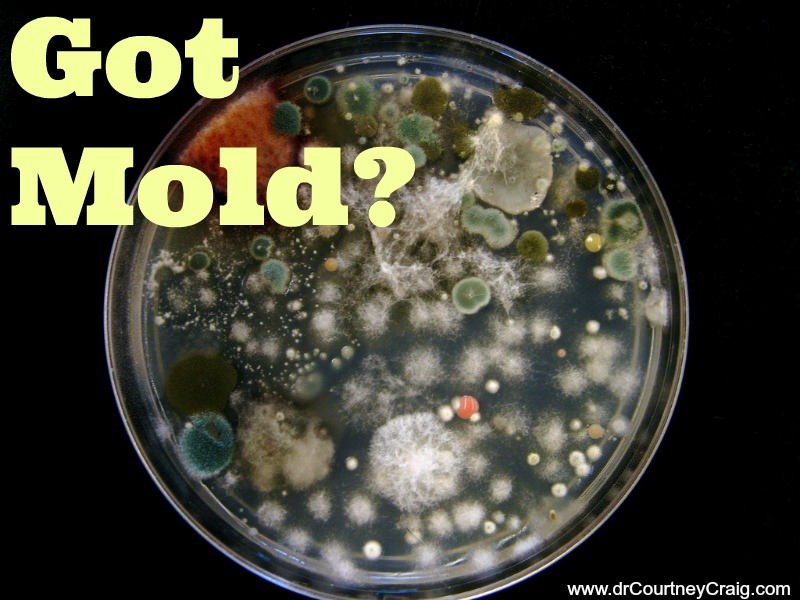Moldy? 4 Ways to Test for Mold Illness & Mycotoxins
With a weakened immune system, the uphill battle to improve from ME/CFS can be insurmountable if your everyday environment is against you. Avoidance of known obstacles is paramount for symptom improvement to be possible. This includes the avoidance of immune agonists such as certain foods (gluten/lectins), chemicals (BPA & glyphosates), metals, and allergens (mold).
One of the most challenging of these to accurately assess is mold exposure. Little, if any, research is available yet that determines how problematic mold is for ME/CFS patients. However, some suggest the incidence is worth exploring (1). Certain toxins from mold, known as mycotoxins, have serious health consequences. For example, the mycotoxin aflatoxin can traverse from olfactory neurons housed in our nasal passageways up into the temporal lobe, causing encephalopathy.
4 standard tests can be used as a metric to determine if there is mold in your environment and if that mold is resulting in problems for your health.
Visual Contrast Sensitivity (VCS) Tests Mold
The simplest test to assess the possibility that mold exposure is causing ill effects on your health is a VCS test. This test was developed in the 1990’s by Dr. Ritchie Shoemaker and Dr. Ken Hudnell, of the EPA. An online screening test is available that measures one of the neurologic functions of vision called contrast. According to their work, there is a high likelihood that patients with whom mold is an issue will lose the neurologic function of contrast. Initial testing, treatment showing the test normalizes, and post-exposure testing yielding positive results have all demonstrated the reliability of this straightforward test.
Online VCS tests are available for free at vcstest.com. Dr. Craig recommends periodic assessment of visual contrast to assess treatment response. Do you score better on “good days” and worse on mold-blooming, wet days?
Home Environmental Relative Moldiness Index (ERMI)
About 80% of indoor molds are non-pathogenic. Knowing with certainty if mold is in your home is crucial for those who have been ill without relief for years. ERMI testing is based on methods developed by the EPA and the use of advanced PCR techniques.
The test consists of a sample of household dust from your home. The lab then uses DNA techniques to identify the species of mold that are present in your home. This test may also be a valuable tool for those relocating to new homes or apartments to assess moldiness before moving in.
ERMI testing is available through EM Labs.
Routine Blood Tests for Mold
Dr. Shoemaker’s decades-long practice working with patients affected by mold and biotoxin illnesses has led to standard blood markers that can be ordered by traditional labs (2, 3). If these tests are ordered, consult a physician who is knowledgeable on how to interpret the results!
C4a
Component 4 (C4a) is significant when looking at innate immune responses in those with exposure to mold or biotoxins. The complement system is a group of proteins that work with your immune system and play a role in the onset of inflammation. Each complement activates inflammatory responses; with effects ranging from the innate immune response to the acquired immune response, and blood cell characteristics. Elevated levels of C4a may be associated with mold or biotin illness.
MSH
Alpha-Melanocyte Stimulating Hormone (MSH) is released from the pituitary gland. Deficiency causes abnormal function in the pituitary gland, gastrointestinal system, and immunologic system, and is associated with chronic pain and sleep disturbance. Low MSH levels may be associated with mold or biotoxin illness.
MMP-9
Matrix metalloproteinase 9 (MMP-9) is rarely expressed in healthy tissues. It is secreted during repair and remodeling processes in disease and is a hallmark of elevated pro-inflammatory cytokine levels. It also plays a role in blood-brain barrier integrity, with higher levels leading to “leakiness.” High levels may be associated with mold or biotoxin illness.
VIP
Neuropeptide vasoactive intestinal peptide (VIP) is considered the best indicator of mold or biotoxin illness, according to the work of Dr. Shoemaker. This hormone/cytokine regulates peripheral cytokine responses, pulmonary artery pressures, and inflammatory responses throughout the body. Low levels of VIP may be associated with mold or biotoxin illness.
Mycotoxin Urine Testing
A recent study from Dr. Brewer demonstrated a high incidence (83%) of mold toxins in 112 ME/CFS patients (4). Urine testing looks at specific species of mold to determine the appropriate treatment. This test screens for species including tricothecenes, ochratoxins, and aflatoxins (5).
Urine mold toxin testing is available through Real Time Labs.
A 2022 study from the Nova Southeastern University group aimed to build on Dr. Brewer’s study. Here, they found that in ME/CFS patients (n = 324) who self-reported chronic exposure to mold, 92.4% showed mycotoxins in urine. The specific mycotoxins tested here were aflatoxin (AF), ochratoxin A (OTA), and gliotoxin (GT) (6).
References
1 Chester AC, Levine PH. Concurrent sick building syndrome and chronic fatigue syndrome: epidemic neuromyasthenia revisited. Clin Infect Dis. 1994 Jan;18 Suppl 1:S43-8. http://www.ncbi.nlm.nih.gov/pubmed/8148452
2 Shoemaker RC, House DE. Sick building syndrome (SBS) and exposure to water-damaged buildings: time series study, clinical trial and mechanisms. Neurotoxicol Teratol. 2006 Sep-Oct;28(5):573-88. Epub 2006 Aug 7. http://www.ncbi.nlm.nih.gov/pubmed/17010568
3 Shoemaker, RC & Schmidt, P. Mold Warriors: Fighting America’s Hidden Health Threat. Otter Bay Books (December 29, 2010).
4 Brewer JH, et al. Detection of mycotoxins in patients with chronic fatigue syndrome. Toxins (Basel). 2013 Apr 11;5(4):605-17. http://www.ncbi.nlm.nih.gov/pubmed/23580077
5 Hooper DG, Bolton VE, Guilford FT, Straus DC. Mycotoxin detection in human samples from patients exposed to environmental molds. Int J Mol Sci. 2009 Apr 1;10(4):1465-75. http://www.ncbi.nlm.nih.gov/pubmed/19468319
6 Wu TY, Khorramshahi T, Taylor LA, Bansal NS, Rodriguez B, Rey IR. Prevalence of Aspergillus-Derived Mycotoxins (Ochratoxin, Aflatoxin, and Gliotoxin) and Their Distribution in the Urinalysis of ME/CFS Patients. Int J Environ Res Public Health. 2022;19(4):2052. Published 2022 Feb 12. doi:10.3390/ijerph19042052 https://pubmed.ncbi.nlm.nih.gov/35206241/
